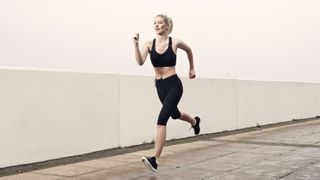What are jogger nipples and how to avoid them?
What are runner’s nipples? This may sound like the start of a cheesy joke, but it’s actually a painful condition caused by blisters on one or both nipples. It can occur in both men and women during exercise, usually in long-distance running where there is prolonged friction between the nipple and clothing.
For women, choosing the best sports bra for running (opens in a new tab) can help, while there are other tricks you can try to avoid them – which we will reveal more about in this article.
What are runner’s nipples?
“Runner’s nipples are blisters that occur when the nipple or nipple rubs repeatedly against a bra or clothing,” says sports physiotherapist and triathlete Claire Fitzpatrick of Fitz & Physio. (opens in a new tab).
“This repeated friction causes painful friction that can sting. It affects both men and women and is very painful! Some nipples are more sensitive and therefore more prone to it. Runner’s nipples can occur all year round. In winter, the cold can make the nipples more erect, which makes this condition more likely, and in summer excessive sweating from the heat can also make things worse.”
“Prevention is important, and much easier than treatment,” says Fitzpatrick, who specializes in pelvic health and helping postpartum mothers return to high-impact sports, including running.
What caused it?
Although there are limited statistics on how common it is, a study published in the Journal List (opens in a new tab) found that 35.7% of people who ran 40+ miles a week experienced runner’s nipple, while only 3.6% of those who ran 15 miles a week or less experienced it.
Runner’s nipples are caused by blisters and can occur with any sport. “It tends to be worse in endurance sports because of sweat buildup and nipple friction,” says Fitzpatrick. “Wet shirts that are exposed to water can then rub against the nipples.”
How to avoid jogger nipples?
“Prevention is important,” Fitzpatrick said. “If nipple blisters have occurred then I would suggest cleaning and drying the wound.
“As with any open wound on the body, you have a greater chance of infection so it is advisable to keep the wound clean and dry. If bacteria get into an open sore on your nipple, the condition may get worse rather than better. ”
Fitzpatrick recommends the following to avoid runner nipples…
- Apply lubricant to your nipples. This helps reduce friction. Apply this before you set out for a run.
- Wear the right clothes: a dry wicking top helps remove moisture from the nipples. Avoid splashing water on your body to cool off: this causes the T-shirt to become heavy and drag on the nipples.
- Applying a bandage over the nipple, or doing nipple exercises are options, but if there is hair around the nipple it can hurt.
- Wear a well-fitting sports bra – because the average female runner’s breasts cover 3.77 miles during a marathon! It is advisable to wear a good bra to prevent excessive movement.
BraStop (opens in a new tab)Bra maker and expert Katie Weir says: “The best way to avoid this is to wear a professionally fitted sports bra – no bust is too small for a bra size. Even the B cups have breast tissue, which will move while running and create blisters if not supported properly.
“Wearing a well-fitting sports bra reduces the movement of breast tissue, by some up to 83%, and therefore stops the movement of the breast up and down. Breathability and comfort are also key when it comes to sports bras. Look for words like CoolMax material, moisture absorption, Polygiene technology, non-compression design – all of these ensure they help prevent dreadful breast perspiration, breast compression and allow your breasts to be comfortably supported while you exercise.”
#jogger #nipples #avoid


Comments
Post a Comment